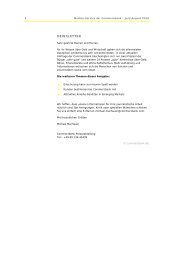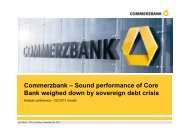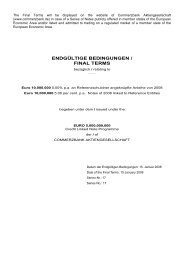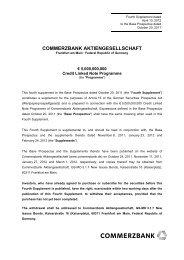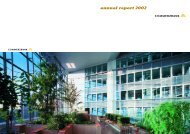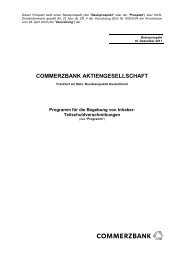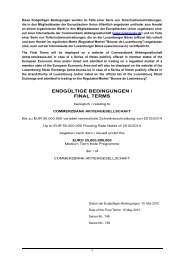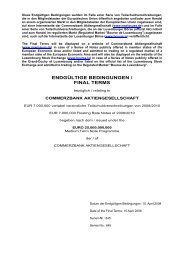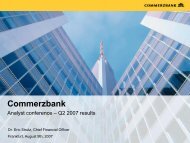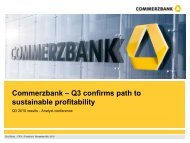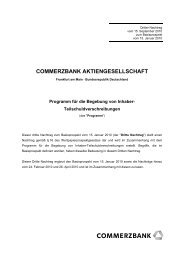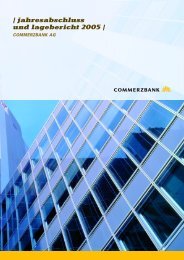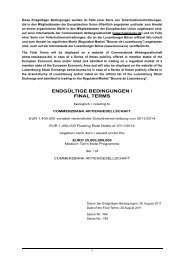COMMERZBANK AKTIENGESELLSCHAFT
COMMERZBANK AKTIENGESELLSCHAFT
COMMERZBANK AKTIENGESELLSCHAFT
Create successful ePaper yourself
Turn your PDF publications into a flip-book with our unique Google optimized e-Paper software.
the Mittelstandsbank, Central and Eastern Europe and Corporates & Markets segments, the economic<br />
downswing is having a direct impact on the demand for credit from companies. Because a weak<br />
economic environment also makes corporate insolvencies and therefore credit defaults more likely,<br />
higher provisions for possible loan losses are required. In addition, because of lower company<br />
valuations, the deteriorating outlook for corporate earnings results in less interest in mergers and<br />
acquisitions and capital market transactions such as initial public offerings, capital increases or<br />
takeovers, and the proceeds from advisory and placement business decline accordingly. Should the<br />
financial market crisis continue, there could be more insolvencies at banks, insurance companies or<br />
other corporations, prompting further deterioration in the overall economic environment. This could<br />
exacerbate the risks described. Thus, the economic downturn has had a material adverse effect on the<br />
Group’s business, results of operations and financial condition, and additional pressure is expected.<br />
Because the markets for securities related to U.S. residential mortgages have been increasingly<br />
illiquid since July 2007, certain categories of securities held by the Group, including securities that<br />
were awarded very good ratings by the rating agencies, have lost a large part of their value over this<br />
period.<br />
The Group is subject to the risk of impairments and losses in respect of both financial instruments with<br />
subprime exposure and other structured financial instruments, and this risk will remain until market<br />
sentiment and the liquidity of these products experience a material and sustained improvement. The<br />
Group’s holdings of structured financial instruments with and without subprime exposure, in particular<br />
structured credit products as well as conduits 3 , which primarily comprise liquidity facilities/backup lines<br />
in favor of the conduits administered by the Group. Most of the securitized asset portfolios underlying<br />
the conduits stem from customers, with a smaller portion from the securitization of the Bank’s own<br />
loan receivables within the scope of active credit risk management. These asset portfolios are highly<br />
diversified and do not include any of the subprime RMBS 4 instruments affected by the crisis.<br />
The Group continues to hold substantial positions in financial instruments with subprime exposure as<br />
well as other structured instruments. In the Group’s opinion, the markets for these securities will be<br />
subject to liquidity bottlenecks for the foreseeable future. At present, it is not possible to forecast how<br />
long these bottlenecks will persist and whether they might even become more severe. It is, therefore,<br />
certainly possible that the Group will incur further significant charges upon the disposal of financial<br />
instruments with subprime exposure and other structured instruments, or in the event of defaults on<br />
these instruments, liquidity bottlenecks in the relevant markets or other developments relevant from a<br />
valuation perspective.<br />
Should the Group no longer be in a position to use valuation models to calculate the fair value of<br />
financial instruments with subprime exposure and other structured instruments, future write-downs<br />
and/or losses could prove to be even greater than in the past. A decline in the fair value of an asset or<br />
an increase in the fair value of a liability gives rise to a corresponding charge in the income statement.<br />
Depending on the extent of the change in value, the level of this charge could be significant and entail<br />
a substantial loss. Calculating the fair value of financial instruments with subprime exposure or other<br />
structured instruments on the basis of actual market or indicative prices could result in far lower fair<br />
values in future if market prices reach substantially lower levels than those of model prices. Prices<br />
could reach a very low level if portfolios of structured products were sold at a very large discount to<br />
market values. If amendments were made to – or if there were changes in the interpretation of – the<br />
relevant accounting standards, the regulatory framework or the rating agencies’ criteria, such changes<br />
could compel the Group to alter its existing valuation models in respect of structured financial<br />
instruments with and without subprime exposure, which would result in concomitant changes to the<br />
respective fair values.<br />
3<br />
Conduits are special-purpose vehicles whose only corporate purpose is to issue securities to purchase receivables as part of<br />
an asset securitization.<br />
4<br />
RMBS or residential mortgage-backed securities are asset-backed securities where the receivables securitized are real estate<br />
loans secured by mortgages on residential property.<br />
44



